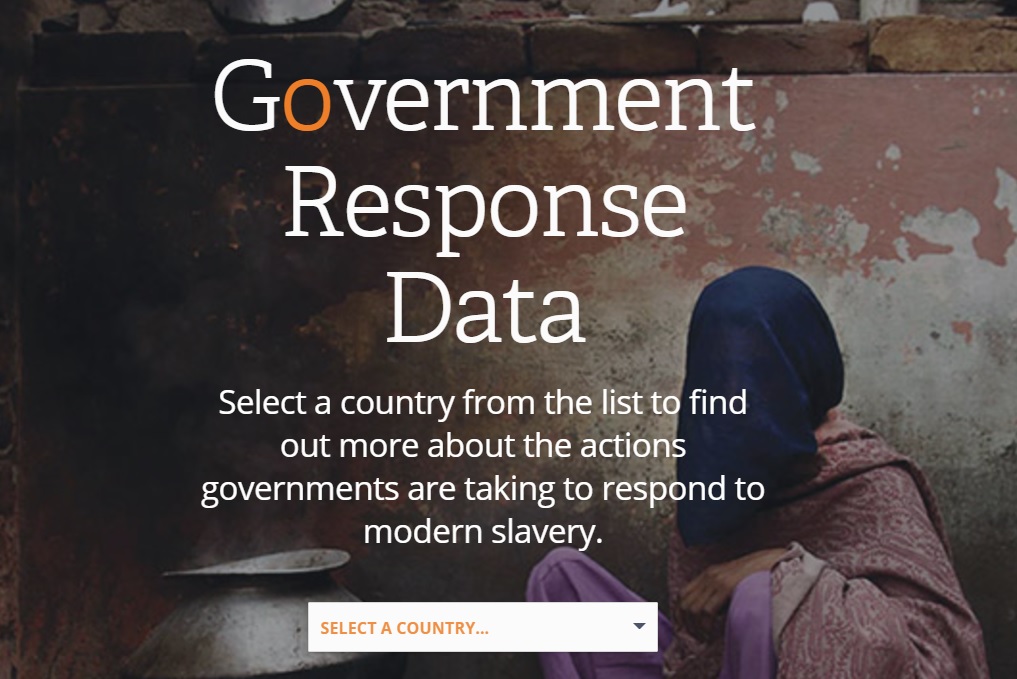
July 15, 2017, by Rights Lab
Global Research for Global Problems: Government Responses
By Emily Brady
Working on the Walk Free Foundation’s government response database is a fascinating, thought-provoking, and troubling experience. As a researcher going from knowing relatively little about the global situation of modern day slavery to spending several months conducting detailed research into the topic, I was exposed to just how extensive this global problem is, and how useful the work conducted by the Walk Free Foundation is in combating modern slavery.
One of the first projects completed under the agreement between the Walk Free Foundation and the University of Nottingham is the update of the assessment of government responses to modern slavery, housed in the Walk Free Foundation database. This forms part of the preparations for the 2018 edition of the Global Slavery Index (GSI).
The Walk Free Foundation has developed a conceptual framework of what constitutes a ‘strong’ government response to modern slavery, in line with various international instruments. The framework broadly follows a 4P response to trafficking – provision of victim support services, criminal justice responses, coordination and accountability mechanisms, and responding to context specific risk factors. As the 2018 GSI will be focusing on supply chains and the role of business, this year the framework includes a more detailed assessment of the steps government can take to regulate private and public procurement.
Multiply this conceptual framework across 167 countries, and you end up with 17,000+ datapoints, all of which have to be identified by desk research, verified by in-country experts and then quality checked. Hundreds of hours go into conducting this research, with 20 researchers and 80 NGOs all across the globe coming together to tackle this enormous undertaking, and in doing so, working together to confront this global problem.
One of the difficulties of conducting this research is a lack of information and government-led research into modern slavery. While some governments make qualitative and quantitative research into human trafficking and modern slavery central to their responses, others fail to conduct even the most basic research, or fail to collate simple figures charting the number of victims, or number of investigations. Even when governments do collect data, this information may not be made public, or it may be too vague to draw many conclusions. In this way, important trends can be overlooked.
However, the GSI’s detailed framework – consisting of 100 datapoints per country – makes it harder for distinctions between countries to go unreported.
One such distinction and key finding from this year’s GSI research is the lack of male-centric support services in some areas of the world, such as Central and South Asia. Although men, women and children remain vulnerable to modern slavery in most areas of the world, there tends to be more victim support services available for female rather than male victims. In several countries in Central Asia – Kazakhstan, Tajikistan, Turkmenistan, Uzbekistan, and Kyrgyzstan -the biggest demographic vulnerable to slavery is male victims of forced labour. Their profile is 18-34 years old, married with dependent children, no higher education and a low monthly income.
Yet the vast majority of male victims do not apply for support at all: according to a 2015 report interviewing 250 identified male trafficking victims across Central Asia, less than 50% of male victims apply for any assistance at all. This varies country to country: in Kyrgyzstan, Turkmenistan and Tajikistan only 11.9%, 13.3% and 17.5% applied respectively. Although the figures are higher in Kazakhstan and Uzbekistan, at 46.7% and 48% respectively, the majority still do not apply for assistance. Key reasons for this are lack of trust in government, the perceived overly long and complex support process, and belief that it will make no difference. One victim stated that: “…we have such mentality – male victims of trafficking hide their status and try to solve their problems independently or with the involvement of relatives, but not with the help of outsiders…” Because of a feeling of shame, many male trafficking victims are slipping through the cracks.
This is where the GSI and the government response database comes in. By housing all this information in one place we’re able to provide researchers with an incredible tool to see how governments around the world are responding to male victims of modern slavery. It provides policy makers with examples of good practice, as well as identifying current gaps in specific responses. Moreover, it provides NGOs with the tools to create evidence-based advocacy campaigns to drive action to continually improve responses to modern slavery, including providing for the specific needs of male victims. Crucially, it provides a global study that does not neglect the distinctions between each country, providing a tailored, country-specific tool for researchers and governments alike.
Emily Brady is a postgraduate research student in the School of Cultures, Languages and Area Studies at the University of Nottingham. In 2017 she was one of a team of postgraduate researchers at the University of Nottingham who worked with Katharine Bryant (Research Manager at the Walk Free Foundation) on the Global Slavery Index’s government response database.

I hope to see more updates from you. Thank you!